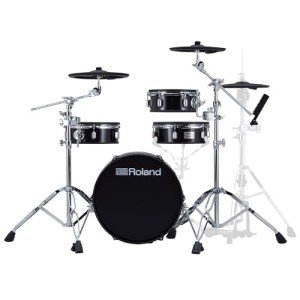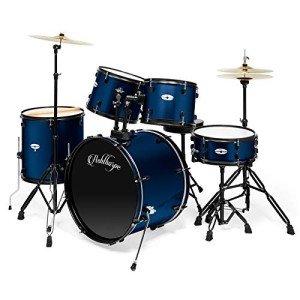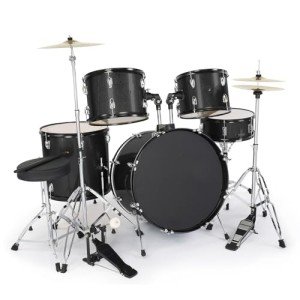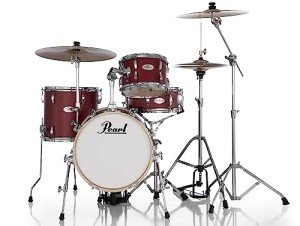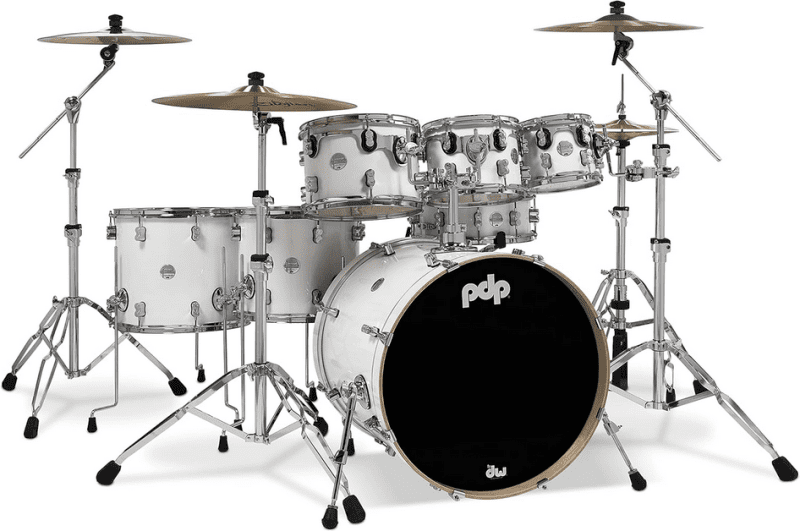Revised Article: 9-16-24
Learning to play the drums is an exciting journey that can lead to a deeper appreciation of music and rhythm. With the right resources and dedication, anyone can start learning drums today. Whether someone is drawn to rock, jazz, or any other genre, drumming offers a unique way to express creativity and build coordination.

Choosing the right drum set is an important first step, as it can help set the stage for effective practice. Beginners can also benefit from various learning methods, including online drum lessons, instructional books, and video guides. Many options are available, from interactive apps providing real-time feedback to self-teaching techniques that fit personal schedules.
As new drummers progress, developing technique and proper posture helps improve their skills. With time and practice, they can enhance their playing experience and master the fundamentals that lay the groundwork for more advanced drumming styles.
Key Takeaways
- The right drum set supports effective practice.
- Multiple resources exist for learning, from books to online lessons.
- Mastering technique and posture is vital for skill development.
Choosing Your Drum Set

Selecting the right drum set is a crucial step for beginners. It impacts the learning experience, comfort, and enjoyment. This section covers the differences between acoustic and electronic kits, essential components of a drum set, and how to set it up properly for optimal playing.
Acoustic vs Electronic Drum Kits
When choosing between an acoustic and an electronic drum kit, there are several factors to consider.
Acoustic Drum Kits:
- Sound Quality: Acoustic kits provide a natural sound. They are often preferred by those who enjoy playing in bands or live settings.
- Physical Feel: Many drummers like the feel of hitting real drumheads and cymbals.
- Space Requirement: Acoustic sets can take up more room and can be noisy.
Electronic Drum Kits:
- Volume Control: They allow for quiet practice using headphones, which is great for apartment living.
- Variety of Sounds: Electronic kits often come with various built-in sounds and effects.
- Practice Features: Many include learning tools and connectivity for recording.
Each type has its benefits and drawbacks based on personal preference and living situation.
Essential Drum Kit Components
A basic drum kit typically includes several key components:
- Bass Drum: The largest drum, played with a foot pedal, provides the foundation of the beat.
- Snare Drum: Positioned between the drummer’s legs, it produces a sharp sound that is essential for accents.
- Tom-Toms: Usually two mounted and one floor tom, these drums add depth and rhythm to patterns.
- Cymbals: This includes the hi-hat (often used for timekeeping), ride cymbal (provides a sustained sound), and crash cymbal (used for accents).
Understanding how each piece contributes to the overall sound helps in effectively learning to play.
Setting Up Your Drum Set
Setting up the drum kit correctly is vital for comfort and performance.
- Bass Drum Placement: Position the bass drum at the center.
- Snare Drum Position: Place it between the knees at a comfortable height.
- Tom-Toms Arrangement: Mount toms above the bass drum at a slight angle for easy access.
- Cymbal Setup: The hi-hat should be to the left, with the ride cymbal and crash cymbal positioned on the right.
Adjusting each component for ergonomic reach is essential. Proper setup promotes good playing habits, making practice more enjoyable and effective.
Learning Drum Fundamentals

To start learning drums effectively, understanding core fundamentals is essential. These basics include familiarizing oneself with drum rudiments, mastering rhythm and timing, and learning how to read drum sheet music. Each area builds a solid foundation for future drumming skills.
Drum Rudiments
Drum rudiments are the building blocks of drumming technique. They consist of simple patterns that help drummers develop skills in control and coordination. Common rudiments include:
- Single Stroke Roll: Alternating between the right and left hand.
- Double Stroke Roll: Two strokes per hand.
- Flams: A grace note played before the main note.
Practicing these rudiments regularly improves speed and precision. Drummers should focus on maintaining even sound and consistent timing while playing. They can start slow and gradually increase speed as they become more comfortable.
Understanding Rhythm and Timing
Rhythm and timing are crucial for any drummer. Drummers perform within a time signature, which sets the structure of the music. A common time signature is 4/4, meaning there are four beats in a measure.
Drummers must learn different note values. For example:
- Quarter Note: Gets one beat.
- Eighth Note: Gets half a beat.
Counting beats aloud helps develop a strong sense of timing. Practicing with a metronome can reinforce steady tempo and accuracy, allowing drummers to play in sync with other musicians.
Reading Drum Sheet Music
Reading drum sheet music unlocks a new level of drumming. It provides specific guidance on what to play. The basic components include:
- Staff: The five lines where notes are placed.
- Notes and Rests: Represent what to play and pauses.
- Time Signature: Indicates the beat structure.
Drummers should recognize various note values, such as quarter notes and eighth notes, and how they relate to timing. A chart can help visualize this:
| Note Type | Value |
|---|---|
| Quarter Note | 1 Beat |
| Eighth Note | 0.5 Beat |
Familiarity with these elements allows drummers to interpret and perform music accurately. Practice reading simple rhythms before advancing to more complex pieces.
Developing Technique and Posture

Understanding the proper technique and posture is vital for anyone starting to learn drums. This foundation helps prevent injuries and allows for better performance. Focusing on stick grip, body alignment, and limb independence will enhance a drummer's skills.
Effective Stick Grip and Movement
A good stick grip enhances control and reduces fatigue. Beginners should hold the drumsticks with a loose yet firm grip. This involves placing the stick between the thumb and index finger, allowing the other fingers to wrap gently around it.
Wrist movement is crucial for effective drumming. Instead of using the arms, drummers should rely primarily on the wrists. This technique allows for faster and more precise beats, especially during syncopation. Regular practice of basic rudiments will help reinforce stick techniques.
Optimal Drumming Posture
Proper drumming posture can significantly affect performance. Drummers should sit on a comfortable drum throne adjusted to the right height. The knees should be slightly lower than the drum, allowing for easy access to pedals.
A straight back is essential to avoid discomfort. Shoulders should be relaxed but not slouched. Elbows should rest comfortably at the side of the body. Maintaining this alignment can prevent strain and enable better use of technique while drumming.
Building Limb Independence
Limb independence is a key skill every drummer must develop. This involves learning to play different rhythms with each hand and foot simultaneously. Beginners should start with simple exercises like playing a basic beat with the right hand while keeping a steady bass drum rhythm.
As skill improves, it’s important to integrate syncopation into practice sessions. Gradually, drummers can experiment with more complicated patterns and fills. Regular practice will enhance coordination and allow for creative expression in drumming.
Practical Skills Development

Developing practical skills in drumming is essential for any beginner. Focusing on basic drum beats, mastering tempo with a metronome, and employing effective practice strategies can build a solid foundation for future growth in drumming.
Learning Basic Drum Beats and Fills
To start, learning basic drum beats is crucial. These beats form the backbone of most songs. Beginners should focus on simple patterns like:
- Bass drum on beats 1 and 3
- Snare drum on beats 2 and 4
- Hi-hat played on each eighth note
Once comfortable with basic beats, she should move on to simple drum fills. A fill is often a break in the drumming pattern, adding flair before transitioning back to the main beat. Simple fills can include hitting the snare or toms in quick succession, providing a smooth connection in a song.
Mastering Tempo with a Metronome
Using a metronome is a valuable practice tool. A metronome helps maintain a consistent tempo. Setting it at a slow pace permits beginners to play along smoothly. They should gradually increase the tempo as confidence builds. For effective practice:
- Start slow: Begin at a manageable speed.
- Focus on timing: Ensure each hit aligns with the metronome’s beat.
- Increase tempo: Gradually raise the speed to challenge skills.
This method promotes timing and rhythm, important components for solid drumming ability.
Practice Strategies for Improvement
Setting specific drumming goals can significantly enhance practice. A structured approach keeps learning engaging. He or she should use a practice pad for warm-ups and to develop stick control. Establishing a routine that includes:
- Warm-up exercises: Basic rudiments are great for coordination.
- Playing along to songs: This combines fun with skill application.
- Recording practice sessions: Listening back helps identify areas for improvement.
Regularly reviewing progress keeps motivation high. Persistence and variety in practice allow for steady improvement in drumming skills.
Enhancing Your Playing Experience
Improving the enjoyment and effectiveness of drumming involves exploring various music genres, collaborating with other musicians, and performing live. Each of these aspects can greatly contribute to a drummer's skills and confidence.
Exploring Different Music Genres
Different music genres provide unique patterns and styles for drummers to learn. This exploration helps a beginner drummer develop versatility and adaptability.
- Rock: Focus on strong beats and fills. Rock drumming often includes heavy use of the bass drum and snare.
- Jazz: This genre encourages intricate rhythms and improvisation. Drummers often use brushes on the snare for a softer sound.
- Pop: Pop music features catchy hooks, so drummers should work on playing consistent beats that support the song's structure.
Exploring genres can lead to increased ear training. Understanding how drums fit into each style enhances musicality and creativity.
Playing With Other Musicians
Collaborating with other musicians significantly enhances the learning experience. Playing together allows for real-time feedback and helps build timing and coordination skills.
- Join a Band: Playing in a group gives a drummer a chance to practice keeping time with other instruments.
- Attend Jam Sessions: These informal gatherings encourage improvisation and experimentation. Drummers can try new techniques and styles.
- Practice with a Metronome: This tool helps maintain a steady tempo, which is crucial when playing with others.
Building these skills helps improve both confidence and performance abilities.
Performing for an Audience
Live performances are a pivotal part of a drummer's growth. Playing in front of an audience can be both thrilling and nerve-wracking.
- Start Small: Begin with low-pressure settings like open mic nights or small gatherings.
- Focus on Technique: Prioritize correct posture and technique, such as using matched grip with drumsticks, to enhance performance quality.
- Gain Experience: Each performance provides valuable lessons. Failing and succeeding in front of an audience helps a drummer refine their skills over time.
Performing regularly boosts confidence and stage presence, making it an essential part of drum learning.
Frequently Asked Questions
Learning to play drums can raise many questions for beginners. Below are some common inquiries and clear answers to help navigate the journey of starting drum lessons.
What are the best resources for beginners to learn to play drums?
Beginners can benefit from various resources. Online courses and video tutorials are popular choices. Books specific to drumming are also helpful for theory and practice. Apps with guided lessons can enhance learning further.
Can I learn to play the drums on my own, and if so, how?
Yes, many people teach themselves to play drums. Starting with online tutorials or drumming apps can be effective. Consistent practice and setting goals help in tracking progress and developing skills.
What steps should a beginner take to start playing drums?
First, a beginner should find a drum set or practice pad. They can then learn basic rhythms and techniques. Regular practice routines, such as focusing on timing and coordination, will support their growth.
How long does it usually take to become proficient at the drums for a beginner?
The time it takes to become proficient varies. With regular practice, many beginners can play simple songs within six months. More complex drumming skills may take several years to develop fully.
Are there any recommended apps for learning to play the drums effectively?
Several apps are designed for drum lessons. Some popular options include “Drum School” and “Simply Drums.” These apps often feature lessons, metronomes, and play-along tracks to assist beginners.
Is there an ideal age to start learning the drums, or is it never too late?
There is no ideal age to start learning the drums. Children as young as five can begin, while adults can also learn at any age. The key is having the motivation and physical ability to practice regularly.

